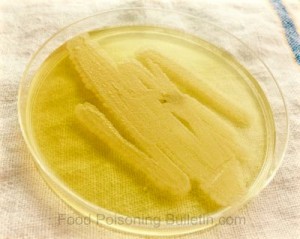The E. coli 0157:H7 outbreak linked to raw milk produced by Foundation Farm in Oregon has sickened at least 19 people. Fifteen of those victims are children; four of those children have developed hemolytic uremic syndrome.
 According to the FDA’s Bad Bug Book, it can take just 10 cells of E. coli bacteria to make someone sick. Dr. Heidi Kassenborg of the Minnesota Department of Health told us that bacteria aren’t evenly distributed in milk fluids, so milk samples withdrawn for testing may not contain any bacteria, when there actually is bacteria in the product.
According to the FDA’s Bad Bug Book, it can take just 10 cells of E. coli bacteria to make someone sick. Dr. Heidi Kassenborg of the Minnesota Department of Health told us that bacteria aren’t evenly distributed in milk fluids, so milk samples withdrawn for testing may not contain any bacteria, when there actually is bacteria in the product.
Hemolytic uremic syndrome (HUS) is a severe complication of an infection of Shiga-toxin producing E. coli, usually E. coli O157. The toxins damage red blood cells, which creates small clots that clog the filtering system in the kidneys, causing HUS. The kidneys always suffer some injury in this condition.
HUS is characterized by hemolytic anemia (too few red blood cells), thrombocytopenia (too few blood platelets), and kidney failure. Complications of HUS include the following:
- Acute renal failure (kidney failure)
- Severe anemia
- Severe high blood pressure
- Central nervous system damage
- Seizures
- Coma
- Thrombotic stroke (blood flow is impaired because of a blockage (thrombosis) to one or more of the arteries supplying blood to the brain)
- Hemorrhagic stroke (breakage or “blowout” of a blood vessel in the brain)
- Hemiplegia (total paralysis of the arm, leg, and trunk on the same side of the body)
- Hemiparesis (weekness on one side of the body)
- Dystonic posturing (movement disorder)
- Diffuse cerebral edema (brain swelling due to excess water)
- Cortical blindness
- Heart failure or other cardiovascular problems
- Respiratory failure
- Gastrointestinal complications
- Necrosis of the colon or ileum
- Hemorrhagic colitis
- Pancreatitis
- Liver damage
- Transient diabetes
- Jaundice
- Rectal prolapse.
In most cases, the first signs of HUS are vomiting, stomach cramps, fever (sometimes), and bloody diarrhea (caused by infection of the intestinal tract with E. coli bacterium). Within a week of onset of these, the person will become weak (lethargic), irritable and have little or no urine that may be red. Additional symptoms at this later stage include seizures, skin rash, yellow skin (jaundice), unexplained bruises, bleeding from the nose or mouth, swelling of the face, hands, feet, or entire body (from severe high blood pressure).
How is HUS diagnosed?
Laboratory tests will show signs of hemolytic anemia and acute renal failure. Laboratory tests may include:
- Blood clotting tests
- Blood tests may show increased levels of BUN and creatinine, decreased red blood cell count, increased white blood cell count, low platelets
- Microscopic examination of a blood sample may find red blood cells that are misshapen
- Urine test may show blood and protein in the urine
- Stool culture may find E. coli (in some cases the E. coli bacterium have passed through and are no longer present)
- Kidney biopsy
HUS Treatment
Treatment may involve:
- Dialysis (does the work of the kidney, filtering wastes and extra fluid from the body)
- Medications
- Transfusion of packed red blood cells and platelets
- Plasmatherapy.
This is a serious illness in both children and adults, and it can cause death. With proper treatment, more than half of patients will recover. The outcome is better in children than adults.




